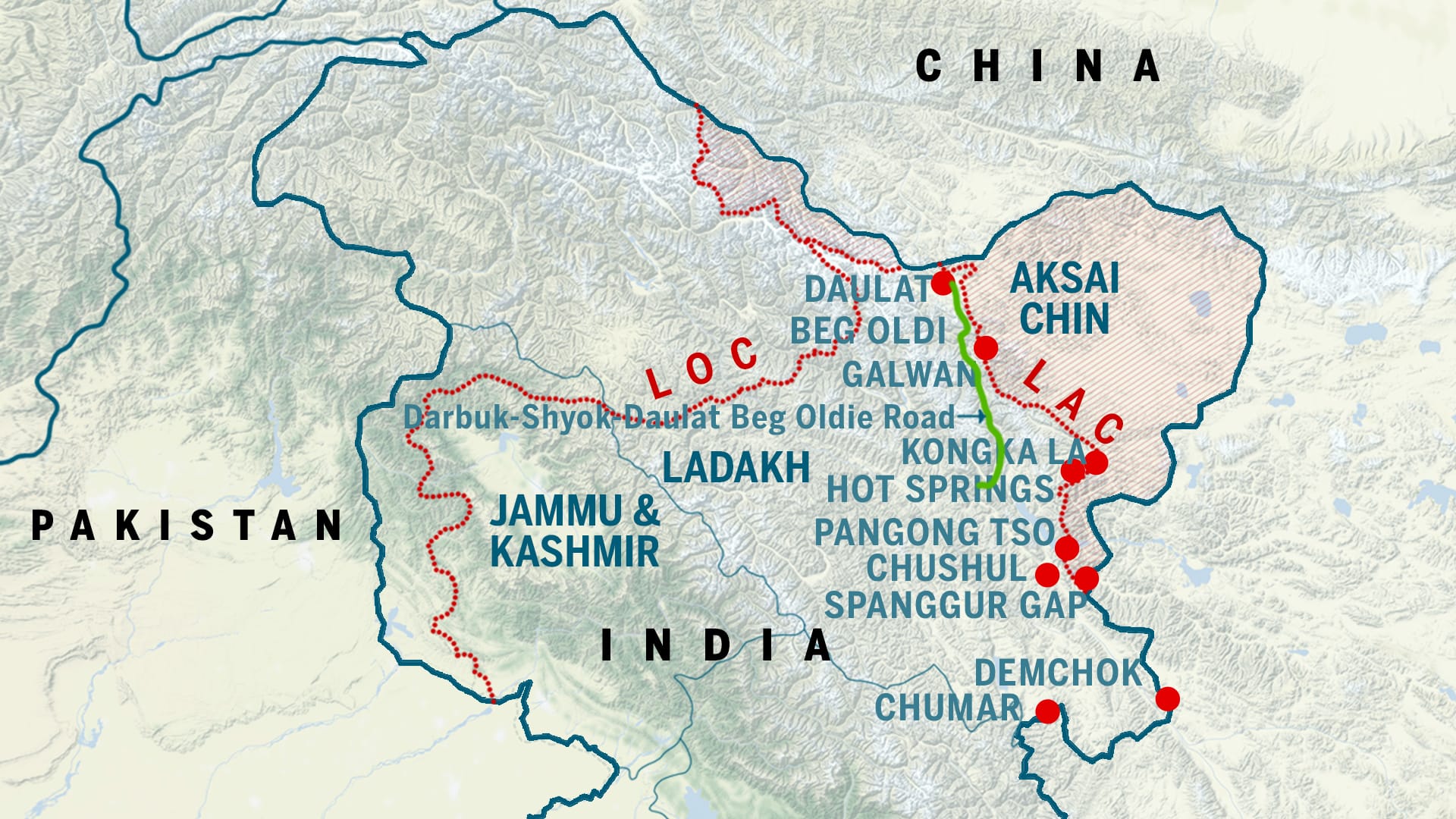LOCATION
- The area between two high mountains, which buffet the Galwan River, is referred to as the valley.
- The river rises in Aksai Chin, which is on the Chinese side of the LAC, and runs eastward to Ladakh, where it merges with the Shyok river, which is on the Indian side of the LAC.
- The valley is ideally situated between Aksai Chin in the east and Ladakh in the west (currently controlled by China)
- The Darbuk-Shyok-Daulet Beg Oldie (DSDBO) road and the Shyok river are located at its westernmost point.
- The G219 highway, currently known as China’s crucial Xinjiang Tibet road, is not far from the river’s eastern outlet.

LINE OF ACTUAL CONTROL
The LAC is located in the valley, up to which both China and India have been patrolling recently, east of the junction of the Galwan and Shyok rivers. China, however, now asserts that the entire valley is on its side of the LAC following the conflict on June 15, 2020. China has been protesting India’s road development efforts at the western end of the valley, between the Galwan-Shyok confluence and the LAC, since early May. Beijing’s current position, which places the line farther to the west towards the Shyok river, claims that the entire valley is on its side of the LAC. India dismissed the assertion, calling it “exaggerated and unsustainable.”
WHAT IS THE ISSUE ?
- In eastern Ladakh’s Pangong Tso, Galwan Valley, Demchok, and Daulat Beg Oldie, the Indian and Chinese soldiers are locked in a standoff.
- At numerous locations, including Pangong Tso, a substantial number of Chinese Army men even crossed onto the Indian side of the de facto boundary.
- The activities on Pangong Tso’s northern bank aim to increase control over the resource-rich lake, not merely for territorial gains on land.
- The stand-off at Ladakh’s Galwan Valley has escalated in recent weeks due to the infrastructure projects that India has undertaken in the recent years. India is building a strategic road through the Galwan Valley – close to China – connecting the region to an airstrip.
- Any construction by India nearby is opposed by China. One of the main flashpoints of the 1962 war was a standoff in the Galwan area.
- There are frequent border “transgressions” because the border, or Line of Actual Control, is not clearly marked and China and India have different opinions on where it should be. A severe border standoff like the current one is less common, despite the fact that this is the fourth one since 2013. Usually these don’t exacerbate tensions.
- Since the disputed 2,200-mile border has long been the source of conflicting claims and tensions, including a brief war in 1962, both nations’ forces have monitored this area.
- Reasons: When the Chinese side disobeyed the consensus to respect the LAC and tried to change the status quo unilaterally, there was a violent confrontation.
- China’s “nibble and negotiate policy” is responsible for it. They want to prevent India from developing infrastructure along the LAC. They use military force to accomplish a political objective while expanding their territory at the same time.
CAN CHINA ALTER THE LAC, BY CITING ITS TERRITORIAL CLAIMS ?
LAC claims are distinct from territorial claims. The LAC that both nations abided by until recently stretched through the valley, regardless of whether China asserts territorial rights to it as one academic argued this week. Sometimes it’s difficult to tell the difference between territorial claims and LAC claims. The LAC only refers to the areas that each party effectively controls, not to the entirety of their territorial claims.
For instance, India claims 38,000 sq km of territory over the entirety of Aksai Chin on the other side of the LAC, despite the fact that India recognises the LAC as passing through the valley. While it is true that the LAC has never been defined and that opinions on its location vary in more than a dozen places, there have never been any problems in the valley. China is allegedly unilaterally modifying the LAC here by laying claim to the entire Galwan Valley and up to the confluence of the rivers.
India and China pledged to “strictly respect and observe the LAC between the two sides,” as stated in the 1993 Border Peace and Tranquility Agreement (BPTA). This made the line of real control in 1959 or 1962 useless because it was referring to the LAC at the time. Additionally, it states that “the two parties shall jointly inspect and determine the portions of the line of actual control where they have differing opinions as to its alignment” if that is necessary.
The 1996 agreement on confidence-building measures and subsequent agreements clearly codify the LAC clarification. To advance this process, China has, however, refused to trade maps in the western region. The two sides concur that references to the line of actual control in this agreement do not prejudge their respective positions on the boundary question, according to the BPTA.
HOW TO DEAL WITH THE PROBLEM?
CLARITY OF THE LAC:
- India should take the initiative to demand that the LAC be clarified as soon as possible. Each side’s perceptions of pockets of different alignment must be clearly established, and these areas must be jointly agreed upon to be demilitarised while negotiations over the boundary are ongoing.
- The current scenario necessitates that diplomatic lines remain open and unhindered in any form, since their seamless operation is essential.
RECONSIDER RCEP ENGAGEMENT–
- The moment has come for India to rethink its position on entering the Regional Comprehensive Economic Partnership as well.
- India cannot be a prisoner of the short term if it wants to sever its economic links with China and develop the domestic industrial capacities and supply chain networks that it requires.
- It is time to courageously adopt a long-term perspective in both this area and its South Asia policy.
CONCLUSION
Several of India’s Asian allies and allies should use the events in Galwan Valley as a wake-up call, allowing them to visualise Chinese aggression at a high resolution. Also, India has the chance to more clearly and unambiguously align its interests with those of the United States, its primary strategic partner, and to rekindle its alliances with Japan, Australia, and the ASEAN.
Other related posts:
Uniform Civil Code – Need of hour?



